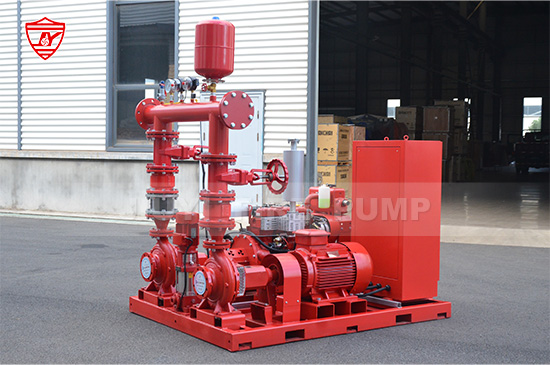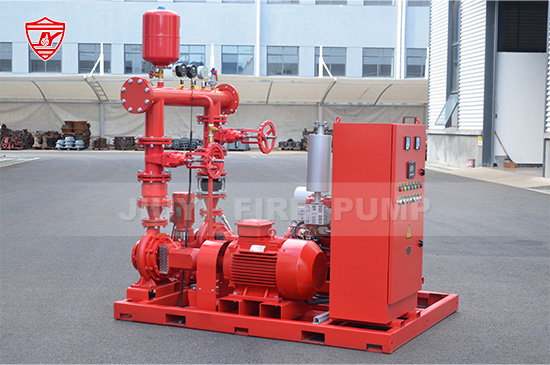A fire pump controller panel is the brain of any fire pump system. It manages the automatic start, operation, and monitoring of fire pumps during emergency conditions. Without proper maintenance, even the best fire pump can fail to start when it’s needed most. That’s why regular inspection, testing, and servicing of the controller panel are vital to ensure system reliability and compliance with NFPA 20 standards.
In this article, we’ll explore the key steps to maintain a fire pump controller panel, common issues to look out for, and best practices to keep your fire protection system performing at its best.

Before diving into maintenance, it’s essential to understand what the controller panel does. The fire pump controller panel:
Receives start signals from pressure sensors or manual switches.
Initiates and monitors pump operation (either electric or diesel-driven).
Provides alarms and status indicators for power failure, low voltage, or phase loss.
Ensures automatic transfer to emergency power (for electric fire pumps).
Records operational data for performance evaluation and compliance reporting.
Essentially, the controller ensures the fire pump activates reliably under emergency conditions — a function that must never fail.
A well-maintained controller panel ensures:
Immediate and automatic start-up when fire demand occurs.
Compliance with NFPA 20 and local fire codes.
Prevention of costly repairs due to electrical or mechanical failures.
Longer lifespan of the controller and connected equipment.
Assurance of system readiness for fire emergencies.
Neglecting maintenance can lead to issues such as relay failure, corroded terminals, loose wiring, or malfunctioning sensors — all of which can stop the fire pump from operating when it’s needed most.
A typical fire pump controller includes:
Main circuit breaker and disconnect switch – Controls power supply to the system.
Control relays and contactors – Facilitate the start and stop sequences.
Pressure sensing devices – Detect drops in system pressure to trigger the pump.
Indicator lights and alarms – Display system status and fault conditions.
Battery charger (for diesel controllers) – Ensures diesel starting system is charged.
Automatic transfer switch (ATS) – Switches to standby power if the main source fails.
Knowing these components helps you identify what needs regular inspection and testing.
Verify that the controller panel is energized and indicator lights are functioning.
Ensure no alarm signals are active (such as phase failure or low battery).
Check the room temperature — should typically be above 40°F (4°C).
For diesel-driven systems, confirm battery charger indicators show normal charging.
Conduct a weekly fire pump churn test (no-flow test) as recommended by NFPA 25.
Observe the controller’s automatic start function by simulating a pressure drop.
Verify that the pump starts, runs smoothly, and shuts down automatically.
Record voltage and current readings to ensure balanced power supply.
Inspect all control relays, fuses, and wiring connections for corrosion or looseness.
Check manual start and stop switches for correct operation.
Test the alarm circuits (power failure, phase reversal, or overload).
Ensure that indicator lamps are operational and replace any burned-out bulbs.
Inspect the pressure transducers or pressure switches for correct calibration.
Review the event log or run-time meter for irregular activity.
Test the automatic transfer switch (for electric fire pumps) to confirm it changes power sources correctly.
Check terminal tightness — loose terminals can cause voltage drops or erratic signals.
Perform a comprehensive controller inspection by a qualified fire protection technician.
Test all control circuits under both normal and simulated emergency conditions.
Inspect printed circuit boards for discoloration, dust buildup, or signs of overheating.
Review and recalibrate all pressure and voltage settings per manufacturer and NFPA 20 requirements.
Clean the panel interior using a dry cloth or compressed air to remove dust and debris.
Even with routine maintenance, certain problems can arise. Below are some common issues and how to address them:
Pump Fails to Start Automatically
Check the pressure sensing line for blockages or leaks.
Verify that control fuses and relays are intact.
Inspect the start circuit for loose or damaged wiring.
Frequent False Starts
The pressure switch may be set too low or faulty.
Look for leaks in the discharge line causing rapid pressure drops.
Alarms Continuously Activated
Inspect the power supply for fluctuations or phase imbalances.
Confirm grounding connections are secure.
Replace any defective indicator lamps or alarm relays.
Battery Charger Malfunction (Diesel Controllers)
Ensure proper AC input voltage to the charger.
Test battery condition with a voltmeter; replace weak batteries.
Clean terminals and clamps to maintain a good connection.
Overheating or Burnt Smell in Panel
Turn off power immediately.
Check for loose terminals, overloaded circuits, or shorted components.
Allow a certified technician to perform further diagnostics.
Follow NFPA 20 and NFPA 25 standards for inspection frequency and procedures.
Keep accurate maintenance records — dates, test results, and corrective actions.
Use only manufacturer-approved spare parts to ensure compatibility and reliability.
Train maintenance personnel to recognize early signs of electrical wear or malfunction.
Protect the panel from moisture and dust — ensure the pump room remains dry and clean.
Schedule professional testing annually with a UL-listed fire pump technician.
These practices not only extend equipment life but also demonstrate compliance during fire authority inspections.
Always disconnect the main power supply before opening the controller panel.
Use insulated tools and PPE when working inside the panel.
Never bypass safety interlocks or alarms during testing.
After servicing, restore all settings to their original state and verify operation.
Label all circuits clearly to prevent confusion during future maintenance.
As a leading manufacturer of fire pumps and controller systems, Better Technology Group provides UL listed and NFPA 20-compliant fire pump packages. Our controller panels are designed for durability, ease of maintenance, and seamless system integration.
We also offer professional technical guidance and spare parts support to help facility managers and fire protection contractors keep their systems running safely and efficiently.
Whether you operate an industrial plant, commercial complex, or high-rise building, proper fire pump controller maintenance is key to ensuring your fire protection system is always ready when emergencies strike.

A fire pump controller panel may seem like a small component, but its reliability determines whether your fire pump system will perform during a real emergency. Regular maintenance — from daily checks to annual inspections — ensures uninterrupted protection and compliance with fire safety standards.
By maintaining your fire pump controller panel according to NFPA 20 and manufacturer recommendations, you’re not just protecting equipment — you’re protecting lives and property.